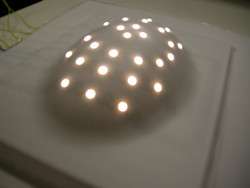Manufacturing flexibility with free-form electronic circuits

'TERASEL was inspired by the need for smart, randomly shaped electronic and sensor circuits for a number of end uses including lighting, car interiors, user interfaces and consumer electronics,' says project coordinator Jan Vanfleteren from IMEC, Belgium. 'Our key objective has been to develop cost effective technologies for the production of these circuits, or 2.5D circuits as we call them.'
Free-form 2.5D circuits are of increasing interest to manufacturers looking to integrate seamless, low cost and energy efficient electronic applications. These circuits are formed from a conventional flat substrate, which is then deformed to the desired 2.5D shape using conventional thermoforming. Key advantages include their easy integration into a wide variety of electronic components, their support for power applications with high currents and voltages and their use of standard circuit board industry equipment.
For the automotive sector, 2.5D circuits will enable the delivery of modular car interior components with all functionalities integrated, reducing assembly complexity, cost and time to market. TERASEL will also help consumer electronics manufacturers to reduce the size of their products further by embedding circuit boards directly in the outer shell of products, and for lighting, the project will offer architects and interior designers the flexibility to place LEDs where they are needed the most.
The project has established industrial production chains in order to produce these circuits in sufficient quantity and quality. 'In this way, end users will have direct access to production lines to develop actual products after the project is completed,' says Vanfleteren. 'Our electronics manufacturing and polymer processing project partners will also have the chance to expand their technology portfolios and obtain exclusive rights in the manufacturing of these products.'
TERASEL's lighting applications were on display at the Ghent Light Festival in January 2015. 'This showed that it was possible to produce, even at lab scale, fairly large numbers – about 50 – of 2.5D circuits for curved LED light sources in a fairly short timeframe,' says Vanfleteren. 'The success of this event gave us confidence in the potential of scaling up the technology to produce large volumes. We are confident that within the coming year we will be able to start small-scale production for end users.'
Potential clients from different application domains have also expressed interest in the TERASEL project's results to date. 'Taking their specifications into account, further work is required to develop particular variants of the technology,' says Vanfleteren. 'But these requests from potential users from a variety of application domains nonetheless suggest that technology transfer to additional industrial manufacturing partners outside TERASEL could be a possibility.'
The TERASEL project builds upon stretchable electronics technology developed in previous European projects such as STELLA (Stretchable Electronics for Large Area Applications) and Place-It (Platform for Large Area Conformable Electronics by inTegration). The project is due for completion in September 2016.
More information: For further information please visit TERASEL project website: www.terasel.eu/
Provided by CORDIS





















